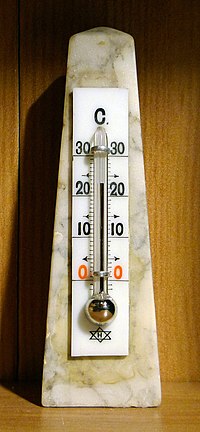
Photo from wikipedia
BACKGROUND Extreme temperature events, including extreme cold, are becoming more frequent worldwide, which might be harmful to pregnant women and cause adverse birth outcomes. We aimed to investigate the association… Click to show full abstract
BACKGROUND Extreme temperature events, including extreme cold, are becoming more frequent worldwide, which might be harmful to pregnant women and cause adverse birth outcomes. We aimed to investigate the association between exposure to low ambient temperature in pregnant women and adverse birth outcomes, such as preterm birth, low birth weight, and stillbirth, and to summarize the evidence herein. METHODS Relevant studies were searched in PubMed, Cochrane, and Embase electronic databases until November 2021. Studies involving low ambient temperature, preterm birth, birth weight, and stillbirth were included. The guidelines of the Preferred Reporting Items for Systematic Reviews and Meta-analyses were followed to conduct this study risk of bias and methods for data synthesis. RESULTS A total of 34 studies were included. First, pregnant women exposed to low ambient temperature had an increased risk of preterm birth (risk ratio [RR] 1.08; 95% confidence interval [CI] 1.04-1.13). Subgroup analyses revealed that exposure during late pregnancy was more likely to induce preterm birth. In addition, only pregnant women exposed to <1st percentile of the mean temperature suffered increasing risk of preterm birth. Moreover, pregnant women living in medium or hot areas were more prone to have preterm births than those in cold areas when exposed to low ambient temperatures. Asians and Blacks were more susceptible to low ambient temperatures than Caucasians. Second, pregnant women exposed to low ambient temperature had an increased risk of low birth weight (RR 1.07 [95% CI 1.03-1.12]). Third, pregnant women had an increased risk of stillbirth while exposed to low ambient temperature during the entire pregnancy (RR 4.63 [95% CI 3.99-5.38]). CONCLUSIONS Exposure to low ambient temperature during pregnancy increases the risk of adverse birth outcomes. Pregnant women should avoid exposure to extremely low ambient temperature (<1st percentile of the mean temperature), especially in their late pregnancy. This study could provide clues for preventing adverse outcomes from meteorological factors. REGISTRATION No. CRD42021259776 at PROSPERO.
Journal Title: Chinese medical journal
Year Published: 2023
Link to full text (if available)
Share on Social Media: Sign Up to like & get
recommendations!